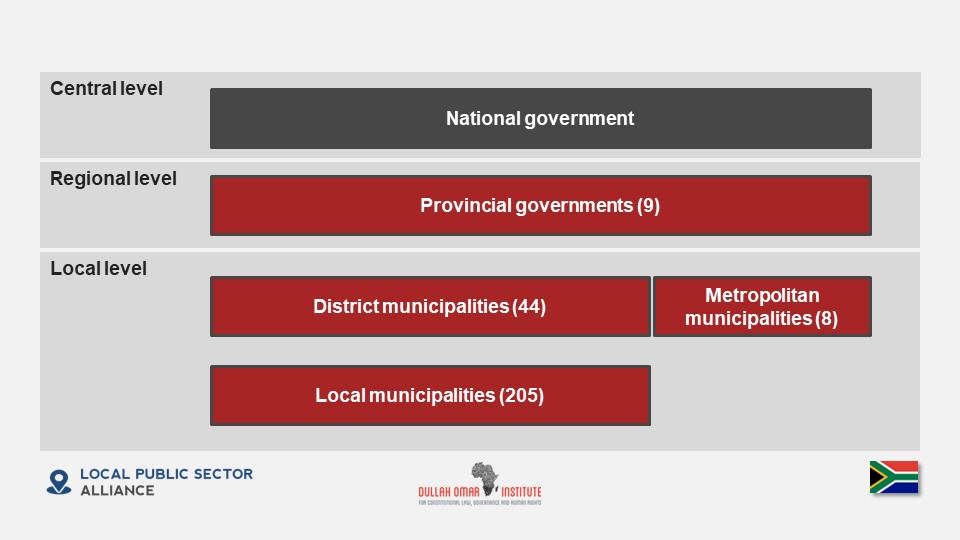
South Africa is a country at the southernmost tip of the African continent. It has a multilevel system of government organized at the national, provincial (regional) and municipal (local) levels. The country’s current system of cooperative multilevel governance is anchored by the progressive Constitution adopted in 1996. The provincial layer of government is constituted by nine provincial governments, which provide major social services such as health, education and social welfare. The local layer of government consists of 257 municipalities of different sizes. Municipalities, which are charged with the delivery of basic municipal services (local roads, solid waste management, water, electricity, sanitation, etc.), are the sphere or tier of government closest to the people. As a result, they tend to have most contact with citizens relative to the central and provincial governments. Provincial and municipal governments in South Africa are both autonomous, highly devolved subnational government entities, with local governments having a somewhat greater degree of autonomy compared to the provincial governments.
Subnational government structure
South Africa is a quasi-federal country as its multilevel system of government has both federal and unitary elements. The 1996 Constitution of South Africa provides the overarching framework for central-provincial-local relations. Provinces are the primary or first territorial-administrative subdivision of South Africa. Local government, comprised of municipalities, is the secondary territorial-administrative subdivision. Municipalities are classified into metropolitan, local and district municipalities.
Nature of subnational governance institutions
Provinces and municipalities in South African meet the criteria of devolved subnational governments with extensive powers and functional responsibilities. Their existence is constitutionally defined and not dependent on the goodwill of higher tiers of government, nor do provincial or local governments require the approval of higher-level governments before implementing laws and policies. However, higher levels of government are equipped with supervisory powers over lower levels of government. In addition, in both law and practice, provinces are less autonomous compared to municipalities.
Functional assignments
The assignment of functions and responsibilities in South Africa is based on the principle of cooperative governance. The 1996 Constitution of South Africa provides that the central, provincial and local spheres of government are distinctive, interdependent and interrelated. This means that while the spheres of government are independent governments in their own right, they rely on each other and must work together to ensure effective delivery of public services to the citizens. The assignment of functional responsibilities to these spheres follows a collaborative rather than individual approach. For instance, the central and provincial governments have concurrent competence over a number of public service functions. Both the central and provincial governments can regulate the exercise of local government functions. Thus, in practice more than one tier of government is often involved in the delivery of a functional responsibility either as a policy setter, funder or actual provider of the public service. However, there are exceptions in areas such as defense, customs, and security- which are reserve for the central government.
LoGICA Assessment
LoGICA Intergovernmental Profile: South Africa 2023 (PDF / Excel)
Additional resources
South Africa Country Profile (Commonwealth Local Government Forum)
South Africa Country Profile (Forum of Federations)
Local government country profile: South Africa (UN Women)
South Africa Country Profile (World Observatory on Subnational Governance and Investment, OECD/UCLG)
Local Government Autonomy in South Africa (Chigwata, 2021)
Back to Local Public Sector Alliance Intergovernmental Profiles – Country Page
Last update: September 22, 2023
